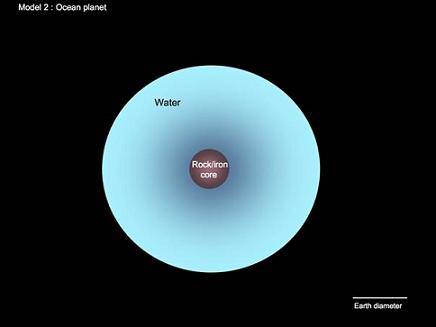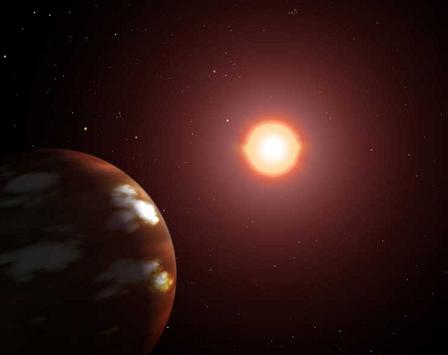An international team with the participation of Professor Zvi Maza from Tel Aviv University and PhD student Avi Shaforer managed to measure for the first time the diameter of a "small" planet outside the solar system

Possible structure of the planet Gliese 436b
An international team with the participation of Professor Zvi Maza from Tel Aviv University and PhD student Avi Shaforer succeeded in measuring for the first time the diameter of a "small" planet outside the solar system. The new measurements show that the planet that is thirty light years away from us is similar to the planet Neptune, and points to a world New, hitherto unknown, of hot ice.
The existence of the planet, Gliese 436b, has been known for about three years. But the mass and diameter of the new planet were unknown until today. In recent weeks, an international team from Switzerland, Belgium and Israel discovered that the light intensity of Gliese 436, the planet's mother star, changes in a regular cycle. The first observations were made in the Alps, continued at the Tel Aviv University Observatory in Mitzpe Ramon, and ended at the Geneva University Observatory on the summit of the Andes in Chile. The observations showed that the light intensity of the star decreases by half a percent for about an hour and then returns to its previous value. Such a periodic phenomenon can only be caused by Gliese 436b, which passes in front of its parent star and hides a small part of the light from our eyes, just as a solar eclipse occurs for us.

A visualization of the planet Gliese 436b near its parent star
More than two hundred planets outside our solar system are currently known. 15 of them are milking their parent star. The eclipse allows astronomers to measure the radius of the planet and its mass, and from this it is possible to calculate its density, which is an important quantity in understanding the structure of the planet and how it formed. All the angelic planets that have been known to date are very large, like the planet Jupiter, which is the largest in the solar system. One of these is HAT-P-2 which was discovered two weeks ago with the participation of the same Israeli team. The planet Gliese 436b is much smaller than Jupiter, so measuring the eclipse it causes is much more difficult. Despite the difficulties, the international team managed to discover the eclipse and estimate the diameter mass of the planet. According to the new measurements, the mass of Gliese 436b is 15 times smaller than the mass of the planet Jupiter and its diameter is "only" 50,000 kilometers, three times smaller than the diameter of Jupiter. In this way, the distant planet is similar to the planet Neptune - located at the edge of the solar system.
However, unlike Neptune, which is four and a half billion kilometers from our Sun, the planet Gliese 436b orbits its parent star in an extremely small orbit, at an average distance of just over four million kilometers. The difference between the two orbits causes a fundamental change - while the temperature on the surface of Neptune is 218 degrees below zero, the temperature on the surface of Gliese 436b reaches over 300 degrees.
From the new measurements it is possible to estimate the composition of the planet. It turns out that Gliese 436b consists mostly of water. Except in the outer layer, the water throughout the depth of the planet is in a state of ice. The pressure of the outer layers increases the pressure and temperature in the depths of the planet, resulting in the formation of hot ice that reaches a temperature of thousands of degrees. Such a state of ice is not found anywhere on earth. We discovered, therefore, in the vastness of space, a new world of hot ice.
The new measurements reinforce the impression that in space there are hidden systems of planets that are fundamentally different from anything we have known so far. The astronomers who study the new planets are similar to the great explorers of the 16th century, such as Columbus and Magellan, who discover new lands that no one imagined existed. The new measurements bring us closer to the stage where we can measure the diameter of even smaller planets, and reach the investigation of planets similar to Earth.
The revealed phenomena make us feel, on the one hand, the greatness of man, who can reach in his investigations to the expanses of vast space, and on the other hand, the nothingness of man compared to the greatness of space and the thousands of different worlds in it.

The telescope at Mitzpe Ramon where some of the measurements were made
Video describing the eclipse (courtesy of Tel Aviv University)

8 תגובות
And God said, Let there be a firmament in the midst of the waters, and let there be a difference between water and water. XNUMX And God made the firmament, and made a difference between the waters which are under the firmament, and between the waters which are above the firmament; And so it was. XNUMX And God called to the sky, heaven; And there was evening and there was morning, Monday.
I agree if everything related to the article..
I think that soon they will also discover living creatures on Mars because they discovered dry streams that used to be water..
I don't believe in aliens but I do believe in settling on Mars..
I like pudding..
And aliens...
If rolled on the head...
=))9999999999999
Has the claim that the new world is populated by panthers been tested?
I heard that in 50 years everyone will be eating Strauss Danone and worshiping potatoes
This is implied in the acceptance
Regarding ice or no ice, I refer readers to the New Scientist source
http://space.newscientist.com/article/dn11864-strange-alien-world-made-of-hot-ice-and-steam.html
The relevant section is this:-
The planet is therefore too compact to be made mostly of hydrogen gas, like Jupiter, the researchers say, but not compact enough to be a rocky 'super Earth', as some had speculated. Instead, they believe it must be made mostly of an exotic form of water.
Although the parent star is much cooler than the Sun, the planet orbits 13 times closer to the star than Mercury's orbit around the Sun. That means the surface must be a blazing hot 300° C or more, keeping water in its atmosphere in vapor form.
But the high pressures in the planet's interior would compress the water so much that it would stay solid even at hundreds of degrees Celsius - the expected temperatures inside the planet. There are a variety of exotic 'hot ice' states possible in such conditions, with names like 'Ice VII' and 'Ice X'.
That is, it is a special type of ice.
For those interested in different types of ice:-
http://en.wikipedia.org/wiki/Ice
Sabdarmish Yehuda
You have to get out of all knowledge frameworks and let your imagination run wild
start to bloom
So it will be with every future discovery of the new worlds,
Otherwise, every discovery will surprise you anew.
We were until now imprisoned by the laws of our solar system
It's over
If you increase the pressure, then water will indeed boil at a higher temperature, as you said, and conversely, if you lower the pressure, the water will boil at a lower temperature. But strangely enough these laws do not exist in freezing, this is a phenomenon called the anomaly of water in water, the more you increase the pressure, the water will reach stagnation only at an even lower temperature and this is because frozen water has a low density, therefore the ice floats (the same amount of water occupies a larger area) therefore the pressure cannot cause to raise the boiling point. It was probably a mistake and the intention was that since it is a tiny star with a low mass, therefore the gravitational attraction there is very low and in any case the pressure created by the upper layers remains low and therefore the water freezes even at the temperature (caused not because of the pressure but because of its proximity to the hot mother star Gliese 436) and despite all This data seems to me that 436 degrees was written as an exaggeration and maybe the nickname was 300 degrees
Nonsense in the juice, raising the pressure in the water only causes the freezing point to drop.